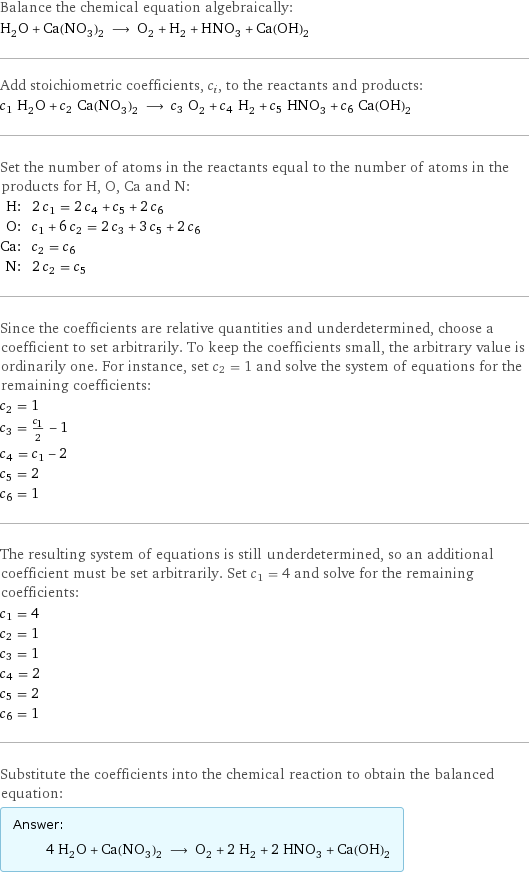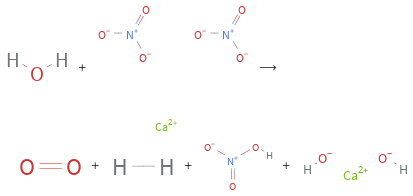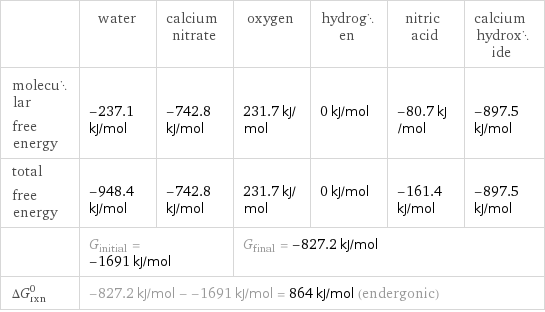Input interpretation

H_2O water + Ca(NO_3)_2 calcium nitrate ⟶ O_2 oxygen + H_2 hydrogen + HNO_3 nitric acid + Ca(OH)_2 calcium hydroxide
Balanced equation

Balance the chemical equation algebraically: H_2O + Ca(NO_3)_2 ⟶ O_2 + H_2 + HNO_3 + Ca(OH)_2 Add stoichiometric coefficients, c_i, to the reactants and products: c_1 H_2O + c_2 Ca(NO_3)_2 ⟶ c_3 O_2 + c_4 H_2 + c_5 HNO_3 + c_6 Ca(OH)_2 Set the number of atoms in the reactants equal to the number of atoms in the products for H, O, Ca and N: H: | 2 c_1 = 2 c_4 + c_5 + 2 c_6 O: | c_1 + 6 c_2 = 2 c_3 + 3 c_5 + 2 c_6 Ca: | c_2 = c_6 N: | 2 c_2 = c_5 Since the coefficients are relative quantities and underdetermined, choose a coefficient to set arbitrarily. To keep the coefficients small, the arbitrary value is ordinarily one. For instance, set c_2 = 1 and solve the system of equations for the remaining coefficients: c_2 = 1 c_3 = c_1/2 - 1 c_4 = c_1 - 2 c_5 = 2 c_6 = 1 The resulting system of equations is still underdetermined, so an additional coefficient must be set arbitrarily. Set c_1 = 4 and solve for the remaining coefficients: c_1 = 4 c_2 = 1 c_3 = 1 c_4 = 2 c_5 = 2 c_6 = 1 Substitute the coefficients into the chemical reaction to obtain the balanced equation: Answer: | | 4 H_2O + Ca(NO_3)_2 ⟶ O_2 + 2 H_2 + 2 HNO_3 + Ca(OH)_2
Structures

+ ⟶ + + +
Names

water + calcium nitrate ⟶ oxygen + hydrogen + nitric acid + calcium hydroxide
Reaction thermodynamics
Gibbs free energy

| water | calcium nitrate | oxygen | hydrogen | nitric acid | calcium hydroxide molecular free energy | -237.1 kJ/mol | -742.8 kJ/mol | 231.7 kJ/mol | 0 kJ/mol | -80.7 kJ/mol | -897.5 kJ/mol total free energy | -948.4 kJ/mol | -742.8 kJ/mol | 231.7 kJ/mol | 0 kJ/mol | -161.4 kJ/mol | -897.5 kJ/mol | G_initial = -1691 kJ/mol | | G_final = -827.2 kJ/mol | | | ΔG_rxn^0 | -827.2 kJ/mol - -1691 kJ/mol = 864 kJ/mol (endergonic) | | | | |
Equilibrium constant
![Construct the equilibrium constant, K, expression for: H_2O + Ca(NO_3)_2 ⟶ O_2 + H_2 + HNO_3 + Ca(OH)_2 Plan: • Balance the chemical equation. • Determine the stoichiometric numbers. • Assemble the activity expression for each chemical species. • Use the activity expressions to build the equilibrium constant expression. Write the balanced chemical equation: 4 H_2O + Ca(NO_3)_2 ⟶ O_2 + 2 H_2 + 2 HNO_3 + Ca(OH)_2 Assign stoichiometric numbers, ν_i, using the stoichiometric coefficients, c_i, from the balanced chemical equation in the following manner: ν_i = -c_i for reactants and ν_i = c_i for products: chemical species | c_i | ν_i H_2O | 4 | -4 Ca(NO_3)_2 | 1 | -1 O_2 | 1 | 1 H_2 | 2 | 2 HNO_3 | 2 | 2 Ca(OH)_2 | 1 | 1 Assemble the activity expressions accounting for the state of matter and ν_i: chemical species | c_i | ν_i | activity expression H_2O | 4 | -4 | ([H2O])^(-4) Ca(NO_3)_2 | 1 | -1 | ([Ca(NO3)2])^(-1) O_2 | 1 | 1 | [O2] H_2 | 2 | 2 | ([H2])^2 HNO_3 | 2 | 2 | ([HNO3])^2 Ca(OH)_2 | 1 | 1 | [Ca(OH)2] The equilibrium constant symbol in the concentration basis is: K_c Mulitply the activity expressions to arrive at the K_c expression: Answer: | | K_c = ([H2O])^(-4) ([Ca(NO3)2])^(-1) [O2] ([H2])^2 ([HNO3])^2 [Ca(OH)2] = ([O2] ([H2])^2 ([HNO3])^2 [Ca(OH)2])/(([H2O])^4 [Ca(NO3)2])](../image_source/50f64bb30c3e73327ee1a31442c2a539.png)
Construct the equilibrium constant, K, expression for: H_2O + Ca(NO_3)_2 ⟶ O_2 + H_2 + HNO_3 + Ca(OH)_2 Plan: • Balance the chemical equation. • Determine the stoichiometric numbers. • Assemble the activity expression for each chemical species. • Use the activity expressions to build the equilibrium constant expression. Write the balanced chemical equation: 4 H_2O + Ca(NO_3)_2 ⟶ O_2 + 2 H_2 + 2 HNO_3 + Ca(OH)_2 Assign stoichiometric numbers, ν_i, using the stoichiometric coefficients, c_i, from the balanced chemical equation in the following manner: ν_i = -c_i for reactants and ν_i = c_i for products: chemical species | c_i | ν_i H_2O | 4 | -4 Ca(NO_3)_2 | 1 | -1 O_2 | 1 | 1 H_2 | 2 | 2 HNO_3 | 2 | 2 Ca(OH)_2 | 1 | 1 Assemble the activity expressions accounting for the state of matter and ν_i: chemical species | c_i | ν_i | activity expression H_2O | 4 | -4 | ([H2O])^(-4) Ca(NO_3)_2 | 1 | -1 | ([Ca(NO3)2])^(-1) O_2 | 1 | 1 | [O2] H_2 | 2 | 2 | ([H2])^2 HNO_3 | 2 | 2 | ([HNO3])^2 Ca(OH)_2 | 1 | 1 | [Ca(OH)2] The equilibrium constant symbol in the concentration basis is: K_c Mulitply the activity expressions to arrive at the K_c expression: Answer: | | K_c = ([H2O])^(-4) ([Ca(NO3)2])^(-1) [O2] ([H2])^2 ([HNO3])^2 [Ca(OH)2] = ([O2] ([H2])^2 ([HNO3])^2 [Ca(OH)2])/(([H2O])^4 [Ca(NO3)2])
Rate of reaction
![Construct the rate of reaction expression for: H_2O + Ca(NO_3)_2 ⟶ O_2 + H_2 + HNO_3 + Ca(OH)_2 Plan: • Balance the chemical equation. • Determine the stoichiometric numbers. • Assemble the rate term for each chemical species. • Write the rate of reaction expression. Write the balanced chemical equation: 4 H_2O + Ca(NO_3)_2 ⟶ O_2 + 2 H_2 + 2 HNO_3 + Ca(OH)_2 Assign stoichiometric numbers, ν_i, using the stoichiometric coefficients, c_i, from the balanced chemical equation in the following manner: ν_i = -c_i for reactants and ν_i = c_i for products: chemical species | c_i | ν_i H_2O | 4 | -4 Ca(NO_3)_2 | 1 | -1 O_2 | 1 | 1 H_2 | 2 | 2 HNO_3 | 2 | 2 Ca(OH)_2 | 1 | 1 The rate term for each chemical species, B_i, is 1/ν_i(Δ[B_i])/(Δt) where [B_i] is the amount concentration and t is time: chemical species | c_i | ν_i | rate term H_2O | 4 | -4 | -1/4 (Δ[H2O])/(Δt) Ca(NO_3)_2 | 1 | -1 | -(Δ[Ca(NO3)2])/(Δt) O_2 | 1 | 1 | (Δ[O2])/(Δt) H_2 | 2 | 2 | 1/2 (Δ[H2])/(Δt) HNO_3 | 2 | 2 | 1/2 (Δ[HNO3])/(Δt) Ca(OH)_2 | 1 | 1 | (Δ[Ca(OH)2])/(Δt) (for infinitesimal rate of change, replace Δ with d) Set the rate terms equal to each other to arrive at the rate expression: Answer: | | rate = -1/4 (Δ[H2O])/(Δt) = -(Δ[Ca(NO3)2])/(Δt) = (Δ[O2])/(Δt) = 1/2 (Δ[H2])/(Δt) = 1/2 (Δ[HNO3])/(Δt) = (Δ[Ca(OH)2])/(Δt) (assuming constant volume and no accumulation of intermediates or side products)](../image_source/4df251a609cd664aa991daf28f30d393.png)
Construct the rate of reaction expression for: H_2O + Ca(NO_3)_2 ⟶ O_2 + H_2 + HNO_3 + Ca(OH)_2 Plan: • Balance the chemical equation. • Determine the stoichiometric numbers. • Assemble the rate term for each chemical species. • Write the rate of reaction expression. Write the balanced chemical equation: 4 H_2O + Ca(NO_3)_2 ⟶ O_2 + 2 H_2 + 2 HNO_3 + Ca(OH)_2 Assign stoichiometric numbers, ν_i, using the stoichiometric coefficients, c_i, from the balanced chemical equation in the following manner: ν_i = -c_i for reactants and ν_i = c_i for products: chemical species | c_i | ν_i H_2O | 4 | -4 Ca(NO_3)_2 | 1 | -1 O_2 | 1 | 1 H_2 | 2 | 2 HNO_3 | 2 | 2 Ca(OH)_2 | 1 | 1 The rate term for each chemical species, B_i, is 1/ν_i(Δ[B_i])/(Δt) where [B_i] is the amount concentration and t is time: chemical species | c_i | ν_i | rate term H_2O | 4 | -4 | -1/4 (Δ[H2O])/(Δt) Ca(NO_3)_2 | 1 | -1 | -(Δ[Ca(NO3)2])/(Δt) O_2 | 1 | 1 | (Δ[O2])/(Δt) H_2 | 2 | 2 | 1/2 (Δ[H2])/(Δt) HNO_3 | 2 | 2 | 1/2 (Δ[HNO3])/(Δt) Ca(OH)_2 | 1 | 1 | (Δ[Ca(OH)2])/(Δt) (for infinitesimal rate of change, replace Δ with d) Set the rate terms equal to each other to arrive at the rate expression: Answer: | | rate = -1/4 (Δ[H2O])/(Δt) = -(Δ[Ca(NO3)2])/(Δt) = (Δ[O2])/(Δt) = 1/2 (Δ[H2])/(Δt) = 1/2 (Δ[HNO3])/(Δt) = (Δ[Ca(OH)2])/(Δt) (assuming constant volume and no accumulation of intermediates or side products)
Chemical names and formulas

| water | calcium nitrate | oxygen | hydrogen | nitric acid | calcium hydroxide formula | H_2O | Ca(NO_3)_2 | O_2 | H_2 | HNO_3 | Ca(OH)_2 Hill formula | H_2O | CaN_2O_6 | O_2 | H_2 | HNO_3 | CaH_2O_2 name | water | calcium nitrate | oxygen | hydrogen | nitric acid | calcium hydroxide IUPAC name | water | calcium dinitrate | molecular oxygen | molecular hydrogen | nitric acid | calcium dihydroxide